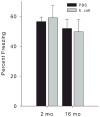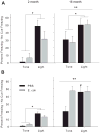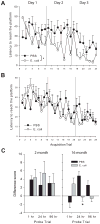Early-life infection is a vulnerability factor for aging-related glial alterations and cognitive decline
- PMID: 20388544
- PMCID: PMC2881165
- DOI: 10.1016/j.nlm.2010.04.001
Early-life infection is a vulnerability factor for aging-related glial alterations and cognitive decline
Abstract
There is significant individual variability in cognitive decline during aging, suggesting the existence of "vulnerability factors" for eventual deficits. Neuroinflammation may be one such factor; increased glial reactivity is a common outcome of aging, which in turn is associated with numerous neurodegenerative conditions. Early-life infection leads to cognitive impairment in conjunction with an inflammatory challenge in young adulthood, which led us to explore whether it might also accelerate the cognitive decline associated with aging. Rats were treated on postnatal day 4 with PBS or Escherichia coli, and then tested for learning and memory at 2 or 16months of age, using two fear-conditioning tasks (context pre-exposure and ambiguous cue), and a spatial water maze task. Neonatally-infected rats exhibited memory impairments in both the ambiguous cue fear-conditioning task and in the water maze, but only at 16months. There were no differences in anxiety between groups. Neonatally-infected rats also exhibited greater aging-induced increases in glial markers (CD11b and MHCII on microglia, and GFAP on astrocytes), as well as selective changes in NMDA receptor subunit expression within the hippocampus, but not in amygdala or parietal cortex compared to controls. Taken together, these data suggest that early-life infection leads to less successful cognitive aging, which may be linked to changes in glial reactivity.
Figures





Similar articles
-
Concurrent hippocampal induction of MHC II pathway components and glial activation with advanced aging is not correlated with cognitive impairment.J Neuroinflammation. 2011 Oct 11;8:138. doi: 10.1186/1742-2094-8-138. J Neuroinflammation. 2011. PMID: 21989322 Free PMC article.
-
Age-related declines in a two-day reference memory task are associated with changes in NMDA receptor subunits in mice.BMC Neurosci. 2007 Jun 22;8:43. doi: 10.1186/1471-2202-8-43. BMC Neurosci. 2007. PMID: 17587455 Free PMC article.
-
Peripheral infection and aging interact to impair hippocampal memory consolidation.Neurobiol Aging. 2006 May;27(5):723-32. doi: 10.1016/j.neurobiolaging.2005.03.010. Neurobiol Aging. 2006. PMID: 15893410
-
Neonatal infection modulates behavioral flexibility and hippocampal activation on a Morris Water Maze task.Physiol Behav. 2014 Apr 22;129:152-9. doi: 10.1016/j.physbeh.2014.02.033. Epub 2014 Feb 24. Physiol Behav. 2014. PMID: 24576680 Free PMC article.
-
A lifespan approach to neuroinflammatory and cognitive disorders: a critical role for glia.J Neuroimmune Pharmacol. 2012 Mar;7(1):24-41. doi: 10.1007/s11481-011-9299-y. Epub 2011 Aug 6. J Neuroimmune Pharmacol. 2012. PMID: 21822589 Free PMC article. Review.
Cited by
-
Infectious burden and cognitive function: the Northern Manhattan Study.Neurology. 2013 Mar 26;80(13):1209-15. doi: 10.1212/WNL.0b013e3182896e79. Neurology. 2013. PMID: 23530151 Free PMC article.
-
Host genetics maps to behaviour and brain structure in developmental mice.Behav Brain Funct. 2025 Jan 2;21(1):1. doi: 10.1186/s12993-024-00261-y. Behav Brain Funct. 2025. PMID: 39748372 Free PMC article.
-
Microglia and memory: modulation by early-life infection.J Neurosci. 2011 Oct 26;31(43):15511-21. doi: 10.1523/JNEUROSCI.3688-11.2011. J Neurosci. 2011. PMID: 22031897 Free PMC article.
-
Microglia as critical mediators linking perinatal immune stress to mental health trajectories.Neuropsychopharmacology. 2025 Jul 9. doi: 10.1038/s41386-025-02162-8. Online ahead of print. Neuropsychopharmacology. 2025. PMID: 40629104 Review.
-
Adolescent morphine exposure affects long-term microglial function and later-life relapse liability in a model of addiction.J Neurosci. 2013 Jan 16;33(3):961-71. doi: 10.1523/JNEUROSCI.2516-12.2013. J Neurosci. 2013. PMID: 23325235 Free PMC article.
References
-
- Barrientos RM, Higgins EA, Sprunger DB, Watkins LR, Rudy JW, Maier SF. Memory for context is impaired by a post context exposure injection of interleukin-1 beta into dorsal hippocampus. Behav Brain Res. 2002;134:291–298. - PubMed
-
- Bennet L, Gunn A. The fetal origins of adult mental illness. In: Wintour-Coghlan M, Owens J, editors. Early Life Origins of Health and Disease (Advances in Experimental Medicine and Biology) New York: Springer; 2006. pp. 204–211.
-
- Bilbo SD, Barrientos RM, Eads AS, Northcutt A, Watkins LR, Rudy JW, Maier SF. Early-life infection leads to altered BDNF and IL-1beta mRNA expression in rat hippocampus following learning in adulthood. Brain Behav Immun. 2008;22:451–455. - PubMed
Publication types
MeSH terms
Substances
Grants and funding
LinkOut - more resources
Full Text Sources
Medical
Research Materials
Miscellaneous

